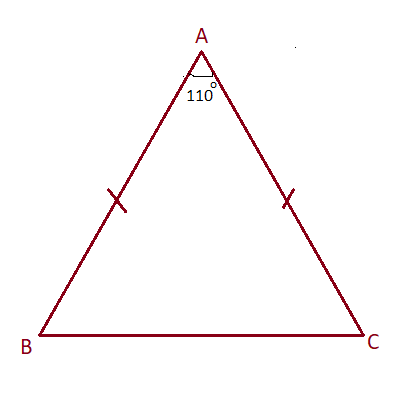
In a triangle ABC, the angle $\angle A = 110_{}^\circ$ and $AB = AC$. Find $\angle B$ and $\angle C$.
Answer
568.8k+ views
Hint: To solve this question we have to apply the concept that as $AB = AC$, therefore their angles must be equal, that is, $\angle B = \angle C$.
Complete step by step answer:
It is given in the question that in triangle \[ABC\],$\angle A = 110_{}^\circ$ and since it is a triangle, so the sum of the angles of the triangle is $180_{}^\circ$.

Therefore by deducting the value of $\angle A = 110_{}^\circ$from the sum of three angles of a triangle that is $180_{}^\circ$ we get
$\Rightarrow \angle A + \angle B + \angle C = 180_{}^\circ$
$\Rightarrow 110_{}^\circ + \angle B + \angle C = 180_{}^\circ$
By deducting $110_{}^\circ$ from $180_{}^\circ$ we get-
$\Rightarrow \angle B + \angle C = 180_{}^\circ - 110_{}^\circ$
$\Rightarrow \angle B + \angle C = 70_{}^\circ$
Now since $AB = AC$ so they will have equal angles which means $\angle B = \angle C$.
Therefore we can write-
$\Rightarrow \angle B + \angle B = 70_{}^\circ$
$\Rightarrow 2\angle B = 70_{}^\circ$
On dividing $2$ on both side we get
$\Rightarrow \angle B = 35_{}^\circ$
Since $\angle B = 35_{}^\circ$ therefore we can write that $\angle C = 35_{}^\circ$
Thus the required values of $\angle B$ and $\angle C$ is $35_{}^\circ$.
Note:
- A triangle is a polygon that has three sides, three vertices, and three edges.
- The sum of the angles of the triangle is $180_{}^\circ$
- There are three types of triangles on the basis of their sides that is the scalene triangle, the isosceles triangle, and the equilateral triangle. On the basis of their angle, there are three types of triangles that are acute-angled triangle, obtuse-angled triangle, and right-angled triangle.
- The sum of its three sides is the perimeter of a triangle.
- The exterior angle of a triangle is always equal to the sum of the interior angles of a triangle.
- The sum of two sides of a triangle is always more than the other remaining side.
- The area of a triangle is always equal to half of the product of base and height.
- The perimeter of a triangle is always twice the semi-perimeter of the triangle.
Complete step by step answer:
It is given in the question that in triangle \[ABC\],$\angle A = 110_{}^\circ$ and since it is a triangle, so the sum of the angles of the triangle is $180_{}^\circ$.

Therefore by deducting the value of $\angle A = 110_{}^\circ$from the sum of three angles of a triangle that is $180_{}^\circ$ we get
$\Rightarrow \angle A + \angle B + \angle C = 180_{}^\circ$
$\Rightarrow 110_{}^\circ + \angle B + \angle C = 180_{}^\circ$
By deducting $110_{}^\circ$ from $180_{}^\circ$ we get-
$\Rightarrow \angle B + \angle C = 180_{}^\circ - 110_{}^\circ$
$\Rightarrow \angle B + \angle C = 70_{}^\circ$
Now since $AB = AC$ so they will have equal angles which means $\angle B = \angle C$.
Therefore we can write-
$\Rightarrow \angle B + \angle B = 70_{}^\circ$
$\Rightarrow 2\angle B = 70_{}^\circ$
On dividing $2$ on both side we get
$\Rightarrow \angle B = 35_{}^\circ$
Since $\angle B = 35_{}^\circ$ therefore we can write that $\angle C = 35_{}^\circ$
Thus the required values of $\angle B$ and $\angle C$ is $35_{}^\circ$.
Note:
- A triangle is a polygon that has three sides, three vertices, and three edges.
- The sum of the angles of the triangle is $180_{}^\circ$
- There are three types of triangles on the basis of their sides that is the scalene triangle, the isosceles triangle, and the equilateral triangle. On the basis of their angle, there are three types of triangles that are acute-angled triangle, obtuse-angled triangle, and right-angled triangle.
- The sum of its three sides is the perimeter of a triangle.
- The exterior angle of a triangle is always equal to the sum of the interior angles of a triangle.
- The sum of two sides of a triangle is always more than the other remaining side.
- The area of a triangle is always equal to half of the product of base and height.
- The perimeter of a triangle is always twice the semi-perimeter of the triangle.
Recently Updated Pages
Master Class 9 Social Science: Engaging Questions & Answers for Success

Master Class 9 Science: Engaging Questions & Answers for Success

Master Class 9 English: Engaging Questions & Answers for Success

Master Class 9 Maths: Engaging Questions & Answers for Success

Master Class 9 General Knowledge: Engaging Questions & Answers for Success

Class 9 Question and Answer - Your Ultimate Solutions Guide

Trending doubts
Which places in India experience sunrise first and class 9 social science CBSE

Fill the blanks with the suitable prepositions 1 The class 9 english CBSE

Write the 6 fundamental rights of India and explain in detail

Difference Between Plant Cell and Animal Cell

What is pollution? How many types of pollution? Define it

What is the Full Form of ISI and RAW




